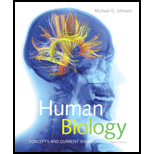
Human Biology: Concepts and Current Issues (8th Edition)
8th Edition
ISBN: 9780134042435
Author: Michael D. Johnson
Publisher: PEARSON
expand_more
expand_more
format_list_bulleted
Concept explainers
Question
Chapter 14, Problem 13TY
Summary Introduction
Introduction:
Fats chemically are triglycerides that are energy stores in the body. There are different kinds of fats like saturated, monounsaturated, unsaturated, or polyunsaturated. Good fats are a very important part of the diet, while bad fats should be avoided as their consumption can cause various cardiovascular diseases.
Expert Solution & Answer
Want to see the full answer?
Check out a sample textbook solution
Students have asked these similar questions
please draw in what the steps are given.
Thank you!
please draw in and fill out the empty slots from image below.
thank you!
There is a species of eagle, which lives in a tropical forest in Brazil. The alula pattern of its wings is determined by a single autosomal gene with four alleles that exhibit an unknown hierarchy of dominance. Genetic testing shows that individuals 1-1, 11-4, 11-7, III-1, and III-4 are each homozygous.
How many possible genotypes among checkered eagles in the population?
Chapter 14 Solutions
Human Biology: Concepts and Current Issues (8th Edition)
Ch. 14 - Do you buy organic foods or conventional foods...Ch. 14 - If you were concerned about the possible harm...Ch. 14 - Describe the organs of the GI tract including the...Ch. 14 - Prob. 2CRCh. 14 - Prob. 3CRCh. 14 - Prob. 4CRCh. 14 - Indicate how many teeth adult humans have.Ch. 14 - Prob. 6CRCh. 14 - Prob. 7CRCh. 14 - Rank the major nutrient groups (carbohydrates,...
Ch. 14 - Prob. 9CRCh. 14 - Prob. 10CRCh. 14 - Which of the GI tract tissue layers is most...Ch. 14 - All of the following are secreted into the lumen...Ch. 14 - All of the following are found in saliva except:...Ch. 14 - Which of the following might be true of an...Ch. 14 -
5. Which of the following nutrients are digested...Ch. 14 - The region of the digestive tract most responsible...Ch. 14 -
7. Which of the following lists structures in...Ch. 14 -
8. What do the enzymes pepsin, chymotrypsin,...Ch. 14 -
9. Once nutrients are absorbed into the...Ch. 14 - Prob. 10TYCh. 14 - Prob. 11TYCh. 14 - Prob. 12TYCh. 14 - Prob. 13TYCh. 14 - Prob. 14TYCh. 14 - Which of the following is associated with celiac...Ch. 14 - Prob. 1AWKCh. 14 - Prob. 2AWKCh. 14 - Prob. 3AWKCh. 14 - Prob. 4AWKCh. 14 - Prob. 5AWKCh. 14 - Prob. 6AWKCh. 14 - Prob. 7AWK
Knowledge Booster
Learn more about
Need a deep-dive on the concept behind this application? Look no further. Learn more about this topic, biology and related others by exploring similar questions and additional content below.Similar questions
- students in a science class investiged the conditions under which corn seeds would germinate most successfully. BAsed on the results which of these factors appears most important for successful corn seed germination.arrow_forwardI want to write the given physician orders in the kardex formarrow_forwardAmino Acid Coclow TABle 3' Gly Phe Leu (G) (F) (L) 3- Val (V) Arg (R) Ser (S) Ala (A) Lys (K) CAG G Glu Asp (E) (D) Ser (S) CCCAGUCAGUCAGUCAG 0204 C U A G C Asn (N) G 4 A AGU C GU (5) AC C UGA A G5 C CUGACUGACUGACUGAC Thr (T) Met (M) lle £€ (1) U 4 G Tyr Σε (Y) U Cys (C) C A G Trp (W) 3' U C A Leu בוט His Pro (P) ££ (H) Gin (Q) Arg 흐름 (R) (L) Start Stop 8. Transcription and Translation Practice: (Video 10-1 and 10-2) A. Below is the sense strand of a DNA gene. Using the sense strand, create the antisense DNA strand and label the 5' and 3' ends. B. Use the antisense strand that you create in part A as a template to create the mRNA transcript of the gene and label the 5' and 3' ends. C. Translate the mRNA you produced in part B into the polypeptide sequence making sure to follow all the rules of translation. 5'-AGCATGACTAATAGTTGTTGAGCTGTC-3' (sense strand) 4arrow_forward
- What is the structure and function of Eukaryotic cells, including their organelles? How are Eukaryotic cells different than Prokaryotic cells, in terms of evolution which form of the cell might have came first? How do Eukaryotic cells become malignant (cancerous)?arrow_forwardWhat are the roles of DNA and proteins inside of the cell? What are the building blocks or molecular components of the DNA and proteins? How are proteins produced within the cell? What connection is there between DNA, proteins, and the cell cycle? What is the relationship between DNA, proteins, and Cancer?arrow_forwardWhy cells go through various types of cell division and how eukaryotic cells control cell growth through the cell cycle control system?arrow_forward
arrow_back_ios
SEE MORE QUESTIONS
arrow_forward_ios
Recommended textbooks for you
 Biology: The Dynamic Science (MindTap Course List)BiologyISBN:9781305389892Author:Peter J. Russell, Paul E. Hertz, Beverly McMillanPublisher:Cengage Learning
Biology: The Dynamic Science (MindTap Course List)BiologyISBN:9781305389892Author:Peter J. Russell, Paul E. Hertz, Beverly McMillanPublisher:Cengage Learning- Nutritional Sciences: From Fundamentals to Food, ...Health & NutritionISBN:9781337486415Author:McGuirePublisher:Cengage
 Biology Today and Tomorrow without Physiology (Mi...BiologyISBN:9781305117396Author:Cecie Starr, Christine Evers, Lisa StarrPublisher:Cengage Learning
Biology Today and Tomorrow without Physiology (Mi...BiologyISBN:9781305117396Author:Cecie Starr, Christine Evers, Lisa StarrPublisher:Cengage Learning


Biology: The Dynamic Science (MindTap Course List)
Biology
ISBN:9781305389892
Author:Peter J. Russell, Paul E. Hertz, Beverly McMillan
Publisher:Cengage Learning


Nutritional Sciences: From Fundamentals to Food, ...
Health & Nutrition
ISBN:9781337486415
Author:McGuire
Publisher:Cengage


Biology Today and Tomorrow without Physiology (Mi...
Biology
ISBN:9781305117396
Author:Cecie Starr, Christine Evers, Lisa Starr
Publisher:Cengage Learning